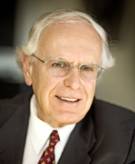MINDLIN LECTURE 2006
SCALING OF FAILURE OF
QUASIBRITTLE
COMPOSITE AND THIN FILMS: ASYMPTOTIC MATCHING

Zdenĕk P. Bažant
ABSTRACT: The lecture begins by a brief discussion of
Midlin’s
pioneering role in the development of continuum models with material
characteristic length, which alter the scaling properties and exhibit
size
effect as their salient feature. It is shown that the size effect must
be taken
into account not only for the deterministic, or mean statistical,
predictions
of nominal strength of quasibrittle structures, but also for the
understrength
part of safety factors. Since concrete structures, as well as other
quasibrittle structures (fiber composite parts of aircraft and ships,
nanoscale
electronic devices, MEMS, rock or ice bodies, tough ceramic parts, soil
slopes)
must be designed for failure probabilities less than one in a million,
the traditional
empirical approach is impossible and the type of probability
distribution
function (pdf) of strength must be deduced theoretically. Based on
Maxwell-Boltzmann statistics of atomic energies and the stress
dependence of
activation energy in the transition state theory, it is demonstrated
that the
pdf of strength of a representative volume element (RVE) of
quasibrittle
material must be Gaussian except for a far-left power-law tail, and
that, with an
increasing size of structure (of positive geometry), there must be a
gradual transition
to Weibull pdf. This transition requires near doubling of the
understrength
safety factor. Experimental verification and calibration of the theory
is
outlined. It further follows that the classical homogenization theory
is
inapplicable in the case of quasibrittle failure. In contrast to
Weibull
theory, exact analytical solutions are impossible but it is shown that
certain
type of asymptotic matching based on the first- and second-order
asymptotic
scaling properties can yield analytical expressions of excellent
accuracy for
the strength statistics of quasibrittle structures. A
new definition of RVE for failure analysis
of structure with softening damage is proposed and the physical meaning
of
Weibul modulus is identified. As an example, the Malpasset dam disaster
is
reexamined and comparisons with stochastic finite element simulations
are
presented. Finally, a ramification of the asymptotic matching approach
to the determination
of the scaling law to thin metallic films with strain gradient effect
and
epitaxially induced boundary layer effect is outlined.
BIO-SKETCH: Educated in
www.civil.northwestern.edu/people/Bazant.html